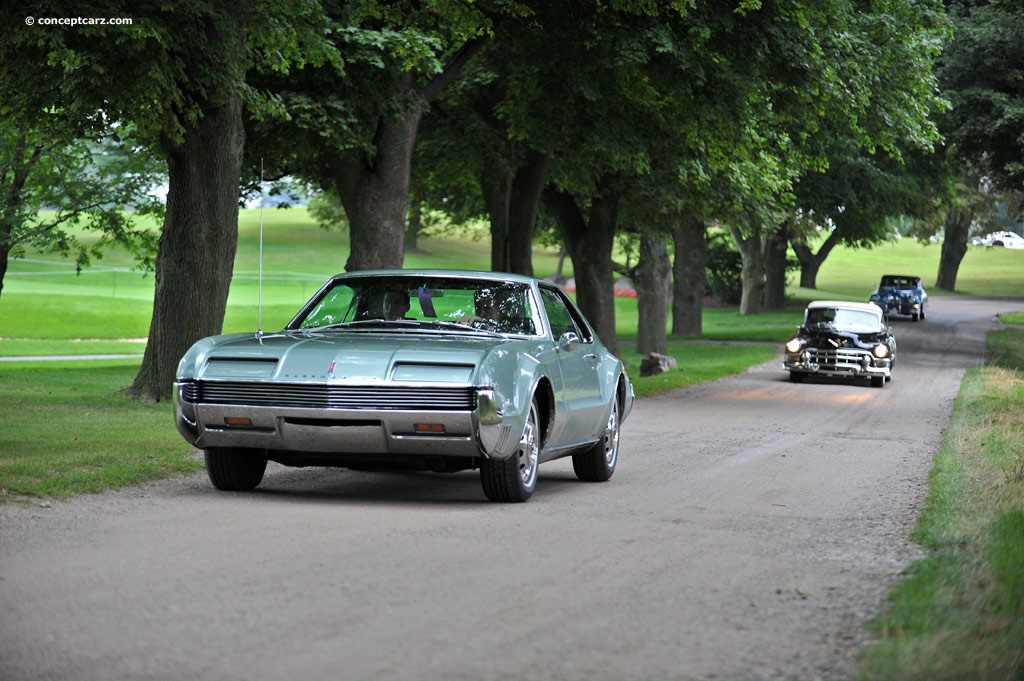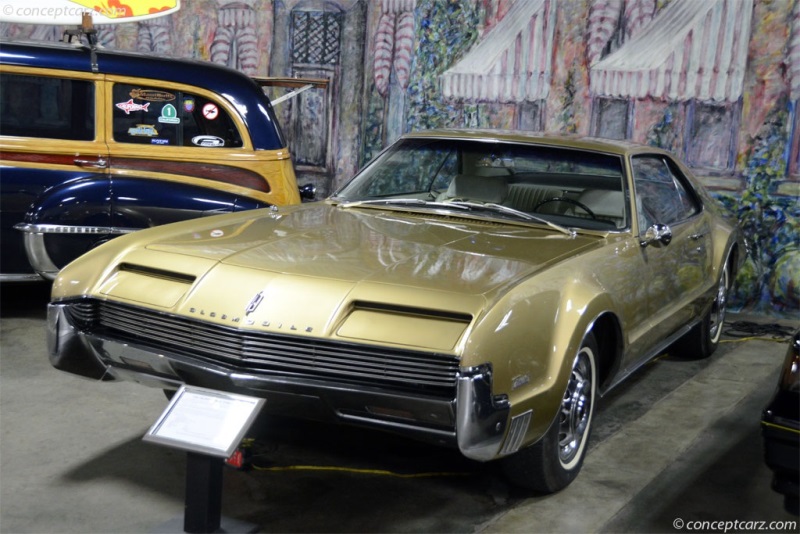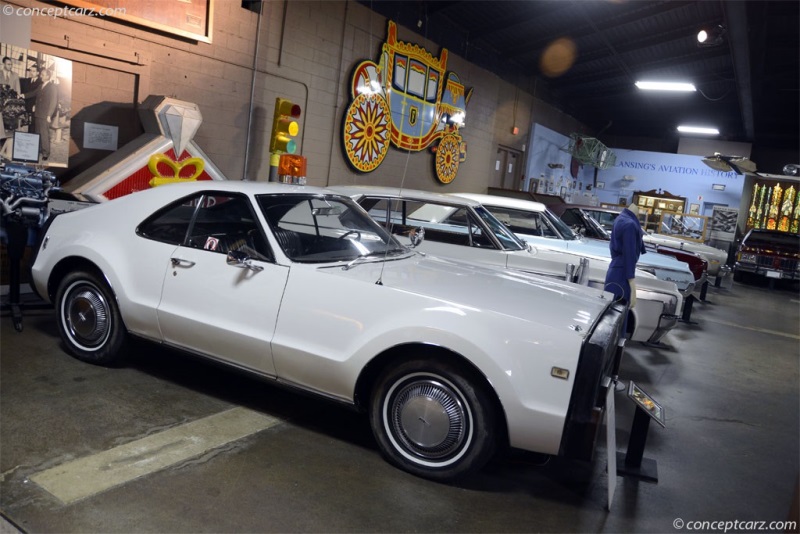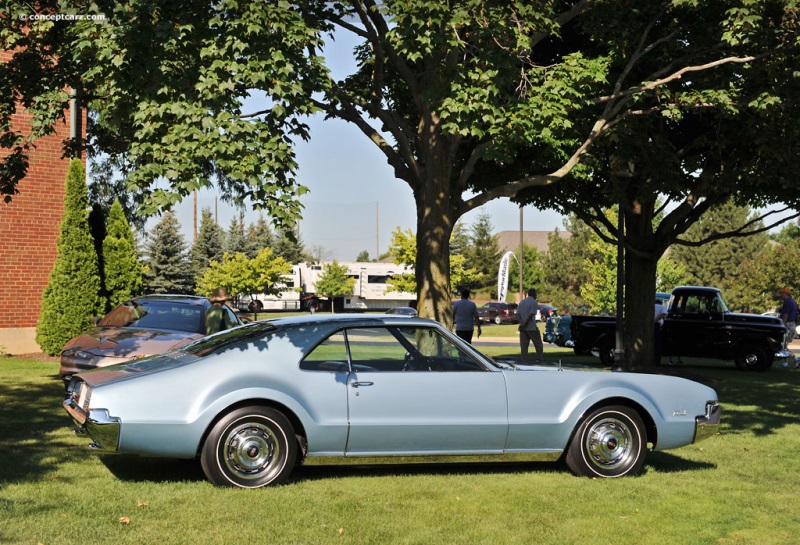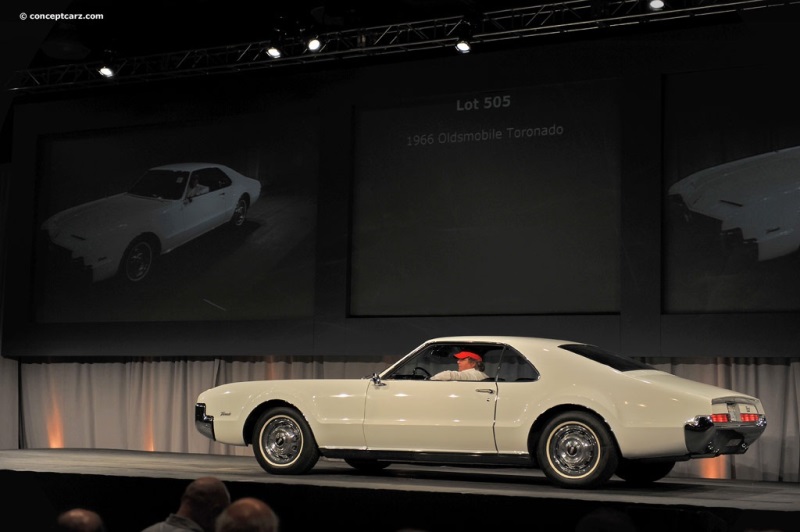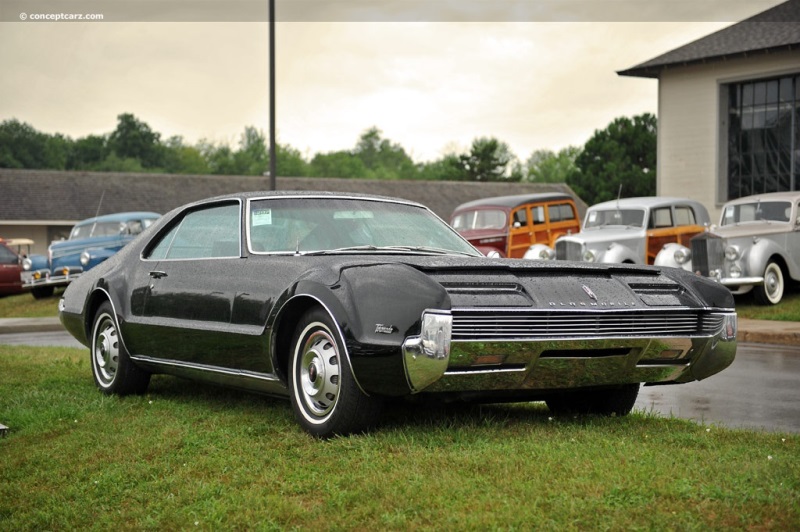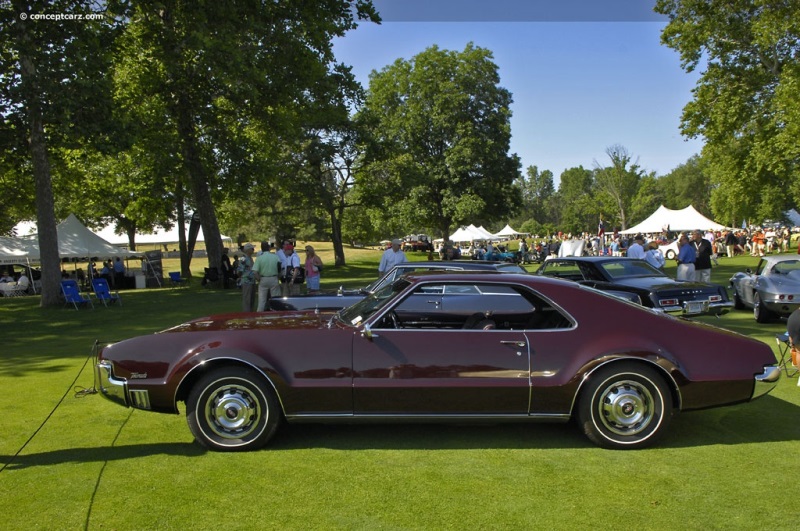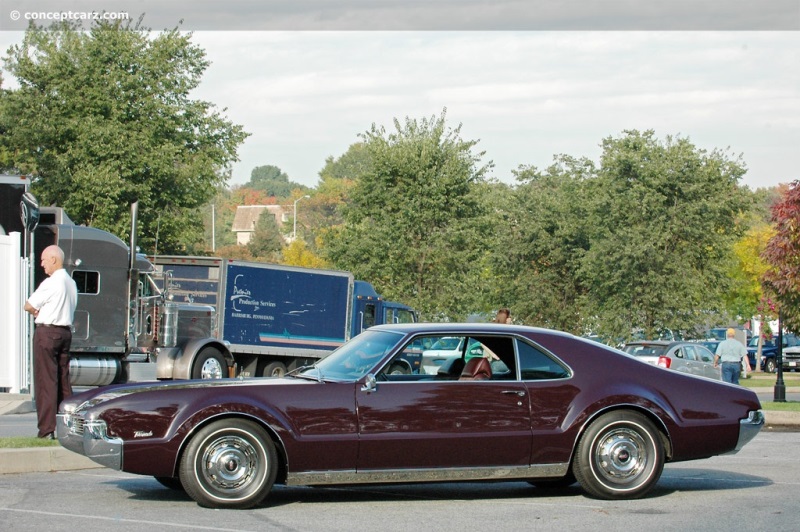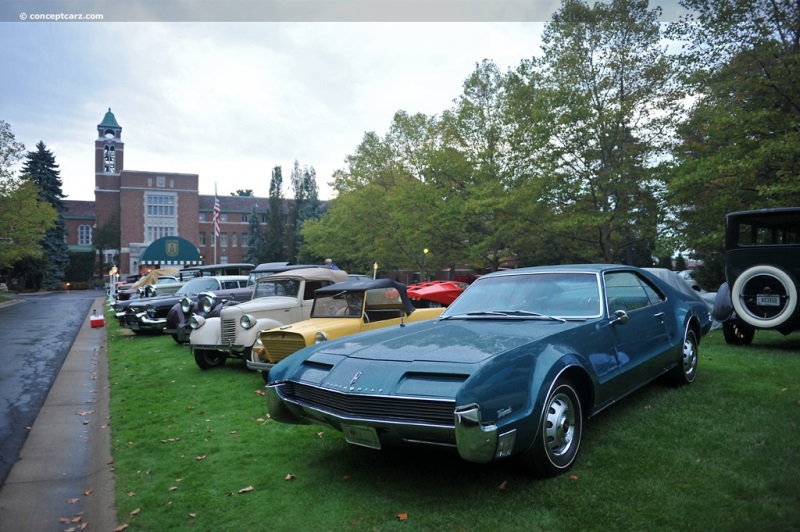The introduction of the Toronado to the Oldsmobile line in 1966 is considered to be among its most significant innovations created during the company's existence. Many consider it the most significant event at Oldsmobile, eclipsing the Hydra-Matic transmission in 1940 and the 'Rocket' V-8 models of 1949. The Toronado was the first front-wheel-drive car from General Motors and the first such American vehicle produced since the Cord 810/812 of the 1930s. Among the accolades bestowed upon the Toronado for 1966 was the Motor Trend Car of the Year honors. Oldsmobile's experimentation with a front-wheel-drive setup began in 1958 with a project led by engineer John Beltz, the individual who originated the 4-4-2 and would later become head of the division. The company's research and experimentation with front-wheel drive had concluded that it would reduce weight, reduce production costs, and improve fuel economy. Additionally, they determined that traction control on front-wheel driven cars is typically better due to the weight of the engine and transmission are directly over the driven wheels. The FWD layout was initially envisioned for the smaller F-85 line, and by 1960 a drivable prototype based on the F-85's wheelbase had been created. The engineering challenges and associated costs with development and experimentation eventually dictated a larger, more expensive car. An engineer at the Ford Motor Company named F.J. Hooven, had patented a similar FWD layout, initially intended for the 1961 Ford Thunderbird. Company president Robert McNamara eventually vetoed it as too costly. The design for the Toronado began as a painting by Oldsmobile stylist David North in 1962. Entitled 'Flame Red Car,' it was envisioned as a personal, compact sports car and never intended for production. Shortly after the design was created, it was learned that the Oldsmobile division would be permitted to build such a car, in hopes of rivaling the Thunderbird for the 1966 model year. Some members of Oldsmobile management, including General Motors styling chief Bill Mitchell, lobbied it to be built on the smaller A-body intermediate platform, but they were eventually overruled due to cost concerns. Even Harley Earl championed the idea of making it into a station wagon. Instead, the E-body shell was selected for production economy, and its introduction would coincide with the introduction of the redesigned 1966 Buick Riviera as it entered its second generation of styling. In the end, North's design was retained, stretched, and given subtle design cues that paid homage to the Cord 810/812. Configuration
Design and development took seven years and included over 1.5 million test miles. The powertrain layout was known as the Unitized Power Package (UPP) that incorporated a compact engine, automatic transmission, and axle/differential into a space that typically held just the engine in a conventional rear-wheel-drive vehicle. Oldsmobile engineers began with a transverse V-6, eventually switching the drivetrain layout to a longitudinal V-8 due to a number of reasons, including corporate pressure. The engine was backed by a modified version of the Turbo Hydra-Matic 400 three-speed automatic rotated 180 degrees and mounted alongside the engine. Early experiments used gears to transfer power from the engine to the transmission, later adopting a single silent chain-drive system developed by the Morse Chain Division of Borg-Warner and called the Hy-Vo. The chains were comprised of very strong hardened steel and required no idler pulleys or tensioners because they had been pre-stretched on a special machine at the factory. As this was an untraditional layout, numerous technological, layout, and design obstacles needed to be overcome. It received GM's first subframe chassis, a partly unitized structure that used a sub-frame that ended at the forward end of the rear suspension leaf springs and providing attachment points for the springs. It housed the floorpan, front suspension, and powertrain, and in this configuration, aided in isolating road and engine noises and vibrations.Due to the confined space, Oldsmobiles used a torsion bar setup for the front suspension, another 'first' for a GM passenger car in the United States, with unequal-length double wishbones. In the back was a beam axle on single leaf springs, with dual shock absorbers with one horizontal and the other vertical. The stopping power was provided by hydraulically-operated 11-inch drums, which would later prove inadequate in controlling the heavy vehicle under hard application, resulting in overheating, considerable fade, and longer stopping distances. This issue was resolved in 1967 with the addition of optional vented front disc brakes.The engine was Oldsmobile's 425 cubic-inch Super Rocket V-8 unit, used in the Ninety-Eight and Starfire 425. With modifications, it delivered 385 horsepower and 475 lb-ft of torque, an increase of 20 hp over the standard 425 engine in the Ninety-Eight. To accommodate engine hood clearance, the intake manifolds shape was depressed. It had overhead valves, hydraulic valve lifters, a Rochester 4GC four-barrel carburetor, 10.5:1 compression, and five main bearings. Special tires were designed specifically for the Toronado by Firestone, measuring 8.85 x15 and called the Toronado-Front-Drive (TFD) tire. While the front wheels of the traditional rear-wheel-drive cars were designed to handle much of the braking load, steering, and the weight of the engine, the FWD Toronado added 'drive' to those duties, plus additional weight from the engine/trans/differential. The Firestone tires had a stiffer sidewall and a unique tread, complimented by a stylishly thin white pin-stripe. Performance
Decades had passed since the front-wheel-drive Cord, and little experimentation with FWD had transpired during that time. Many believed that the front weight bias and additional 'drive' duties would be detrimental to performance and handling. Period testing of the Toronado revealed it suffered from understeer, yet it was not substantially different from other traditional full-size U.S. cars when driven under normal conditions. Rather, many testers praised the Toronado for its handling characteristics under extreme use.
Coupe
Chassis #: 396876M520051
View info and history
Auction entries : 3The 4,500 pound Toronado with its 425 CID V8 was capable of accelerating from rest to sixty mph in 7.5 seconds. The standing quarter-mile was done in 16.4 seconds at 93 mph. The top speed was 135 mph. Interior
The elongated doors allowed for easier entry and exit for rear-seat passengers, and duplicate door-latch handles were added at the rear of each door for closer proximity to back seat passengers. This meant the door latch was within reach of the rear passengers and alleviated the need to reach over or around the front seat.The steering wheel had a unique, stylized shape with a double-delta shaped horn ring. A tilt-telescopic steering column was optional, as were headrests. Behind it was an unusually styled speedometer, with a stationary horizontal 'needle' and a vertically rotating black drum on which the numerals were printed in white. As the vehicle's speed increased, the numerals descended behind the needle.
Coupe
Chassis #: 396876M520051
View info and history
Auction entries : 3There was a Strato-bench front seat with foam seat cushions, an electric clock, Deluxe armrests, courtesy lamps, parking brake light, and carpeting. There was an outside rearview mirror, back-up lamps, a special chrome molding package, and interiors finished in vinyl, leather or cloth. A stereo tape player became optional in 1967. Production
The Oldsmobile Toronado was introduced for the 1965 model year and remained in production through 1970. It had a coupe body style for seating for up to five passengers and had a base price of $4,590. The Deluxe version was priced at $4,780 and proved to be more popular than the standard version with 34,630 examples built. Along with 6,333 of the standard version, a total of 40,963 examples were produced during its inaugural sales year. A slight facelift followed in 1967, plus the optional disc brakes, and a mildly softer ride, but sales fell by nearly half, to 22,062. A total of 26,454 were sold in 1968, 25,073 in 1969, and 25,433 in its final year of 1st Gen styling. A heavily revised styling update in 1971 brought about a slight resurgence in sales, to 28,980 units. In the following years, sales would climb to 48,900 units. The second generation of styling continued through 1978 and was followed by the Third Generation in 1979 lasting until 1985. The fourth and final generation was from 1986 through 1992.1970 Oldsmobile Toronado
Within the Oldsmobile division, the Toronado was at the top in regards to pricing. The F-85 price ranged from $2,320 to nearly $2800. The Vista Cruiser station wagons were priced in the high $2,000s and low $3,000s. The Jetstar 88, in its final year as an Oldsmobile series, was priced similarly to the Vista Cruiser, as were the Dynamic Eighty-Eight, with the most expensive version being the convertible at $3,380. Slightly above the Dynamic 88 was the Delta 88, priced from $3,140 to $3,560 with the top honors going to its convertible. The Startfire, another Oldsmobile personal luxury two-door model, had a factory base price of $3,540. The low 13,019 sales of the Starfire were partly attributed to competition within the Oldsmobile line, specifically from the Ninety-Eight and the Toronado. The Ninety-Eight continued as the company's full-size top-of-the-line model and remained very popular, with nearly 90,000 examples produced. Ninety-Eight prices ranged from $4,130 for the Holiday Hardtop to $4,420 for the convertible. The most popular was the Luxury Sedan priced at $4,200 with 38,123 sales.
Deluxe Coupe
View info and historyThe two-door Oldsmobile Toronado had a price that began at $4,585, however, its more expensive $4,780 version received the bulk of sales. Prices increased by approximately $100 the following year, and another circa-$100 in 1968. During its final year of first-generation production, the Toronado listed for $5,020 for the 'base' coupe and $5,220 for the 'Custom' trim level. With 40,963 examples sold in 1966, the Toronado accounted for approximately seven percent of Oldsmobile's overall sales.
by Daniel Vaughan | Dec 2020
Design and development took seven years and included over 1.5 million test miles. The powertrain layout was known as the Unitized Power Package (UPP) that incorporated a compact engine, automatic transmission, and axle/differential into a space that typically held just the engine in a conventional rear-wheel-drive vehicle. Oldsmobile engineers began with a transverse V-6, eventually switching the drivetrain layout to a longitudinal V-8 due to a number of reasons, including corporate pressure. The engine was backed by a modified version of the Turbo Hydra-Matic 400 three-speed automatic rotated 180 degrees and mounted alongside the engine. Early experiments used gears to transfer power from the engine to the transmission, later adopting a single silent chain-drive system developed by the Morse Chain Division of Borg-Warner and called the Hy-Vo. The chains were comprised of very strong hardened steel and required no idler pulleys or tensioners because they had been pre-stretched on a special machine at the factory. As this was an untraditional layout, numerous technological, layout, and design obstacles needed to be overcome. It received GM's first subframe chassis, a partly unitized structure that used a sub-frame that ended at the forward end of the rear suspension leaf springs and providing attachment points for the springs. It housed the floorpan, front suspension, and powertrain, and in this configuration, aided in isolating road and engine noises and vibrations.Due to the confined space, Oldsmobiles used a torsion bar setup for the front suspension, another 'first' for a GM passenger car in the United States, with unequal-length double wishbones. In the back was a beam axle on single leaf springs, with dual shock absorbers with one horizontal and the other vertical. The stopping power was provided by hydraulically-operated 11-inch drums, which would later prove inadequate in controlling the heavy vehicle under hard application, resulting in overheating, considerable fade, and longer stopping distances. This issue was resolved in 1967 with the addition of optional vented front disc brakes.The engine was Oldsmobile's 425 cubic-inch Super Rocket V-8 unit, used in the Ninety-Eight and Starfire 425. With modifications, it delivered 385 horsepower and 475 lb-ft of torque, an increase of 20 hp over the standard 425 engine in the Ninety-Eight. To accommodate engine hood clearance, the intake manifolds shape was depressed. It had overhead valves, hydraulic valve lifters, a Rochester 4GC four-barrel carburetor, 10.5:1 compression, and five main bearings. Special tires were designed specifically for the Toronado by Firestone, measuring 8.85 x15 and called the Toronado-Front-Drive (TFD) tire. While the front wheels of the traditional rear-wheel-drive cars were designed to handle much of the braking load, steering, and the weight of the engine, the FWD Toronado added 'drive' to those duties, plus additional weight from the engine/trans/differential. The Firestone tires had a stiffer sidewall and a unique tread, complimented by a stylishly thin white pin-stripe. Performance
Decades had passed since the front-wheel-drive Cord, and little experimentation with FWD had transpired during that time. Many believed that the front weight bias and additional 'drive' duties would be detrimental to performance and handling. Period testing of the Toronado revealed it suffered from understeer, yet it was not substantially different from other traditional full-size U.S. cars when driven under normal conditions. Rather, many testers praised the Toronado for its handling characteristics under extreme use.
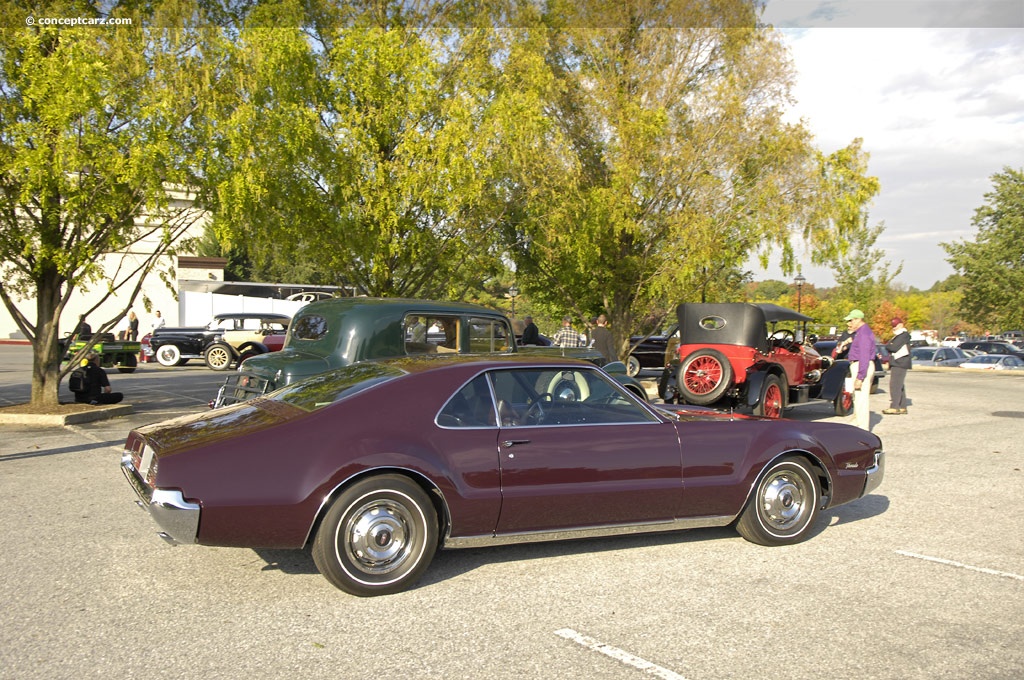
Coupe
Chassis #: 396876M520051
View info and history
Auction entries : 3
The elongated doors allowed for easier entry and exit for rear-seat passengers, and duplicate door-latch handles were added at the rear of each door for closer proximity to back seat passengers. This meant the door latch was within reach of the rear passengers and alleviated the need to reach over or around the front seat.The steering wheel had a unique, stylized shape with a double-delta shaped horn ring. A tilt-telescopic steering column was optional, as were headrests. Behind it was an unusually styled speedometer, with a stationary horizontal 'needle' and a vertically rotating black drum on which the numerals were printed in white. As the vehicle's speed increased, the numerals descended behind the needle.
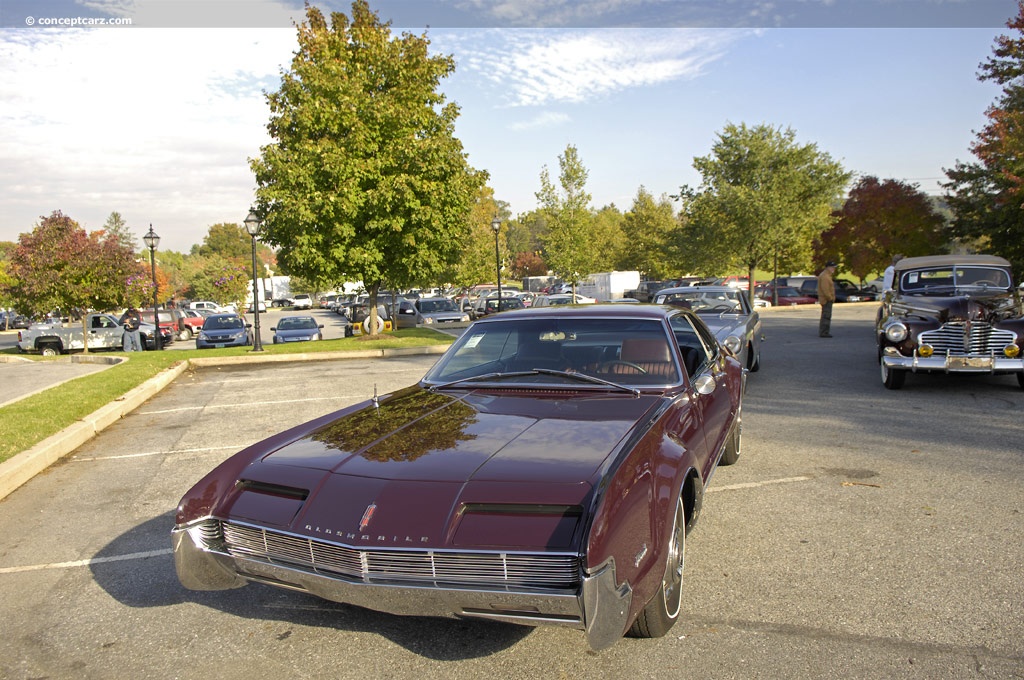
Coupe
Chassis #: 396876M520051
View info and history
Auction entries : 3
The Oldsmobile Toronado was introduced for the 1965 model year and remained in production through 1970. It had a coupe body style for seating for up to five passengers and had a base price of $4,590. The Deluxe version was priced at $4,780 and proved to be more popular than the standard version with 34,630 examples built. Along with 6,333 of the standard version, a total of 40,963 examples were produced during its inaugural sales year. A slight facelift followed in 1967, plus the optional disc brakes, and a mildly softer ride, but sales fell by nearly half, to 22,062. A total of 26,454 were sold in 1968, 25,073 in 1969, and 25,433 in its final year of 1st Gen styling. A heavily revised styling update in 1971 brought about a slight resurgence in sales, to 28,980 units. In the following years, sales would climb to 48,900 units. The second generation of styling continued through 1978 and was followed by the Third Generation in 1979 lasting until 1985. The fourth and final generation was from 1986 through 1992.1970 Oldsmobile Toronado
Within the Oldsmobile division, the Toronado was at the top in regards to pricing. The F-85 price ranged from $2,320 to nearly $2800. The Vista Cruiser station wagons were priced in the high $2,000s and low $3,000s. The Jetstar 88, in its final year as an Oldsmobile series, was priced similarly to the Vista Cruiser, as were the Dynamic Eighty-Eight, with the most expensive version being the convertible at $3,380. Slightly above the Dynamic 88 was the Delta 88, priced from $3,140 to $3,560 with the top honors going to its convertible. The Startfire, another Oldsmobile personal luxury two-door model, had a factory base price of $3,540. The low 13,019 sales of the Starfire were partly attributed to competition within the Oldsmobile line, specifically from the Ninety-Eight and the Toronado. The Ninety-Eight continued as the company's full-size top-of-the-line model and remained very popular, with nearly 90,000 examples produced. Ninety-Eight prices ranged from $4,130 for the Holiday Hardtop to $4,420 for the convertible. The most popular was the Luxury Sedan priced at $4,200 with 38,123 sales.
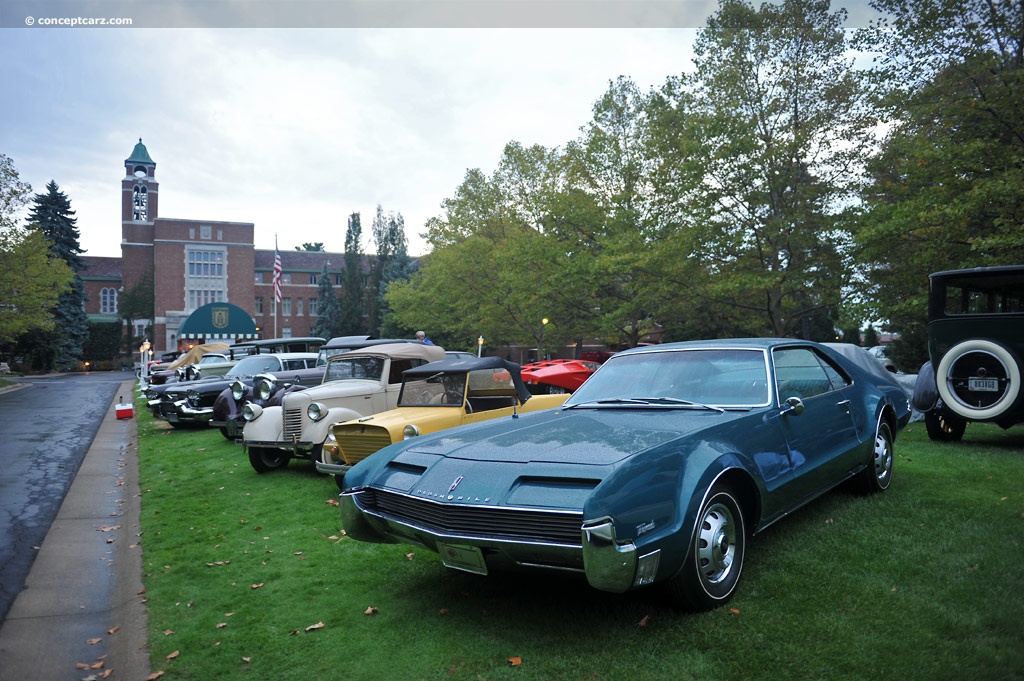
Deluxe Coupe
View info and history
by Daniel Vaughan | Dec 2020
Related Reading : Oldsmobile Toronado History
The Oldsmobile Toronado was sold from 1966 through 1992. It was built as a low-priced luxury car with excellent performance and a revolutionary design. The name Toronado has no meaning it was made up for a 1963 Chevrolet show car. The American automobile manufacutrer Cord had created a vehicle in the mid-1930s that used front-wheel drive. Since that time most American automobiles used rear-wheel....
Continue Reading >>
Continue Reading >>
Similarly Sized Vehicles
from 1966
Similarly Priced Vehicles
1966 Oldsmobile Toronado Vehicle Profiles
Recent Vehicle Additions
Performance and Specification Comparison
Price Comparison
$2,320 - $2,945
$3,535
$4,000 - $4,415
Toronado Specification Comparison by Year
Year
Production
Wheelbase
Engine
Prices
25,433
119.00 in.
8 cyl., 455.00 CID., 375.00hp
8 cyl., 455.00 CID., 400.00hp
8 cyl., 455.00 CID., 400.00hp
$5,025 - $5,215
Related Automotive News

RAM TRUCK TO SHOWCASE OFF-ROAD TRUCK LEADERSHIP AT 2016 OVERLAND EXPO
Overland Expo to host Ram Truck press conference and owner clinic
Fresh off their Chicago Auto Show unveiling, new 2017 Ram Power Wagon and Ram 2500 4x4 Off-road pickups will make their first Arizona appearance at the Overland Expo in Mormon Lake,...

ALL-NEW 2017 HYUNDAI ELANTRA BRINGS ADVANCED TECHNOLOGY AND PREMIUM CONVENIENCE TO THE COMPACT CAR SEGMENT
IMPERIAL BEACH, Calif. January 26, 2016 – The all-new 2017 Hyundai Elantra arrives in dealerships this month, featuring a bold aerodynamic design, a comprehensive suite of safety features, modern interior styling with class-above features, and...

2016 CHEVROLET CRUZE FEATURES NEW ECOTEC ENGINES
New engine family, 6T35 transmission balance power, efficiency and refinement
DETROIT – The 2016 Chevrolet Cruze is powered by General Motors new, global family of Ecotec small-displacement engines, featuring a modular architecture that...

MOPAR GOES ALL-IN WITH FLEET OF CUSTOMIZED SEMA SHOW RIDES
The 15,000-square-foot Mopar Specialty Equipment Market Association (SEMA) Show display will feature Chrysler, Jeep®, Dodge, Ram and FIAT brand vehicles personalized with Mopar products
Hundreds of existing and prototype Mopar parts and accessorie...
2014 MITSUBISHI LANCER EVOLUTION: TURBOCHARGED FUN IN A 4-DOOR SPORTS CAR
Thanks to its potent turbocharged and intercooled powerplant, precision-tuned handling, communicative steering feel and 4-door configuration, the 2014 Mitsubishi Lancer Evolution is an ultra-high-performance sports car that allows the driver to take...
